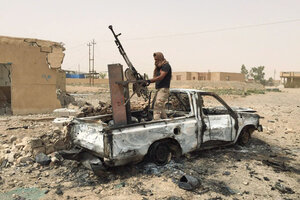A year into bombing ISIS: How successful was the campaign?
After 6,000 coalition airstrikes against the Islamic State in the past year, the jihadist group is still powerful and well-funded, say critics.

A militiaman allied with the Iraqi security forces dismantles a weapon from a vehicle belonging to the Islamic State group, destroyed in an airstrike against IS positions in southern Ramadi, Anbar province, Iraq, Monday, July 20, 2015.
AP Photo/File
Saturday marks the one year anniversary of US-led airstrikes against the self-declared Islamic State, and analysts say the campaign can point to few triumphs.
Over the last year there have been nearly 6,000 coalition airstrikes against ISIS, ABC reports. In addition, 3,300 US military personnel are currently deployed to Iraq, along with an additional 1,200 forces from 17 other countries on the ground to train Iraq’s army.
Earlier this week, the Pentagon announced that the fight against ISIS had cost the US $3.5 billion, with an average daily cost of $9.4 million.
Col. Pat Ryder, a spokesman for US Central Command, highlighted the gains in his remarks to reporters on Friday. As of April, ISIS, also called ISIL, had lost control of 25 to 30 percent of the populated areas it once controlled in Iraq and Syria, he said.
"Over the past year, we have removed several thousand ISIL fighters from the battlefield, as well as dozens of the organization’s senior leaders," he added.
But ISIS has been making up for losses with new recruits, The Hill reports. ISIS still claims to have 20,000 to 30,000 fighters in Iraq and Syria, similar to levels before US-led airstrikes against the group began.
Critics highlight the high costs and few gains in the fight against ISIS.
The Guardian’s Trevor Timm describes the war as "a tragic waste with no clear goal and no end in sight."
He writes, "So far, billions of dollars have been spent, thousands of bombs have been dropped, hundreds of civilians have been killed, and ISIS is no weaker than it was last August, when the airstrikes began."
He also criticizes the civilian deaths caused by airstrikes in the region, saying while the US only admitted to two civilian casualties, a new report by journalists and researchers in the region argues that the real number is closer to 500 civilians.
On the other hand, some critics say the US flew too few airstrikes; they blame the limited gains on an excess of caution.
"The air attacks to date have been what can only be called anemic," David Deptula, a retired Air Force lieutenant general, told NPR. He says ISIS will not be defeated with only a dozen airstrikes a day.
American intelligence agencies say ISIS is fundamentally no weaker than it was a year ago, The Associated Press reported on July 31. They say the would-be caliphate remains a well-funded extremist army that has expanded its power to other countries, including Libya, Egypt's Sinai Peninsula, and Afghanistan.
And still it is not clear when hostilities against ISIS will be over. Ray Odierno, the US Army chief of staff, estimates the fight will last "10 to 20 years."


